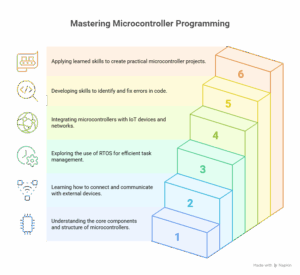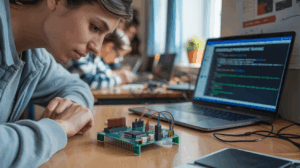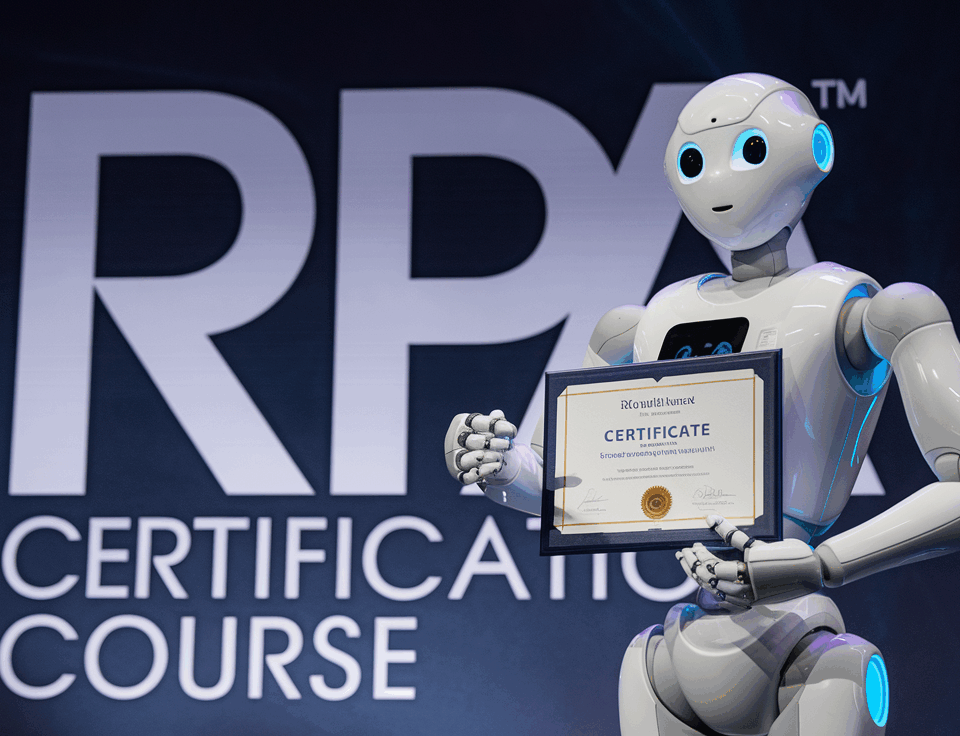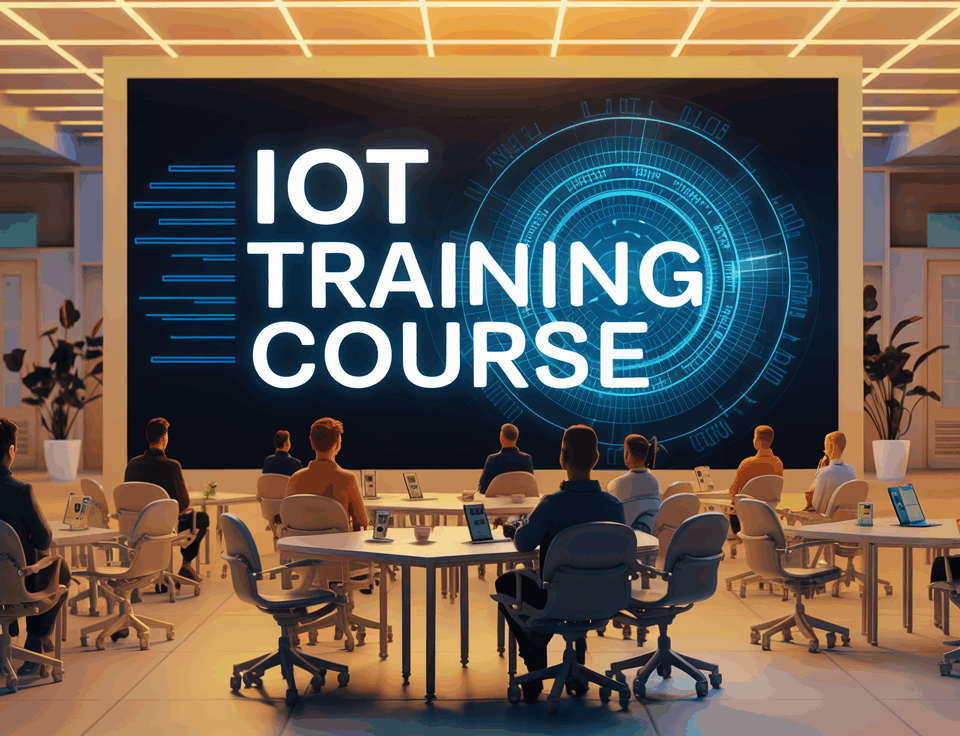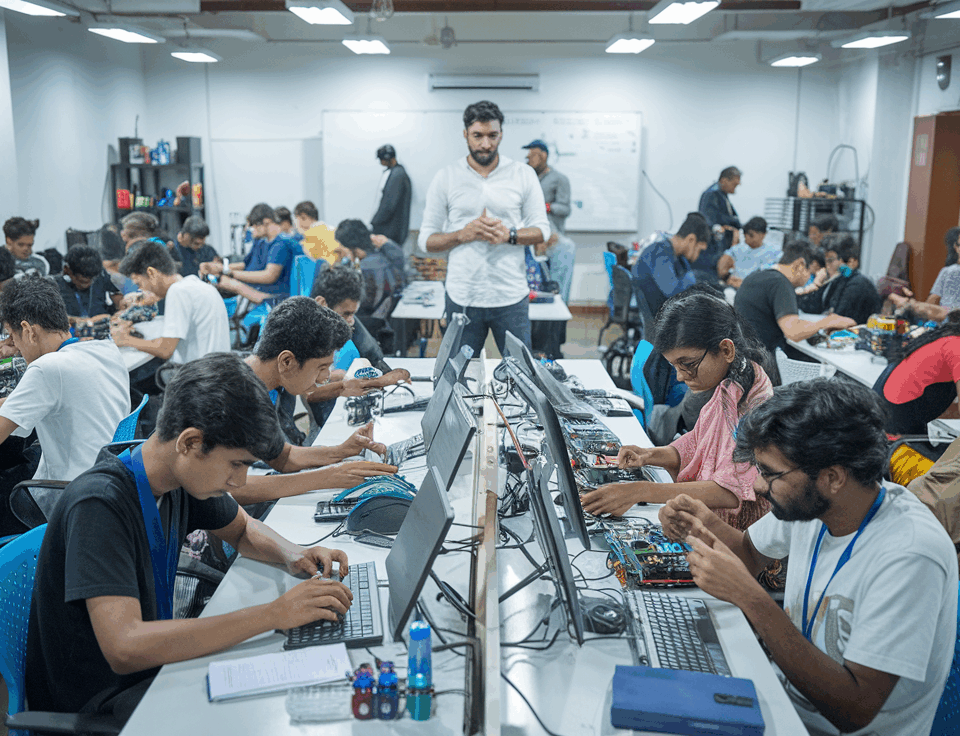
Best Embedded Programming Course | Elysium Embedded School
May 29, 2025
Python certification course by Elysium Embedded School: A Complete Beginner’s Guide to Learning Python Step-by-Step
June 6, 2025
Microcontrollers are the tiny yet powerful brains embedded inside countless electronic devices we use daily. From simple household gadgets like microwave ovens, washing machines, and thermostats to complex automotive systems, industrial machinery, and cutting-edge Internet of Things (IoT) devices, microcontrollers enable intelligent automation and precise control. These embedded systems are often invisible but indispensable, forming a critical backbone of modern technology.
If you are passionate about electronics and software development and want to build a rewarding career in embedded systems or IoT, learning microcontroller programming is essential. Enrolling in a structured microcontroller programming course is the most effective way to acquire the knowledge, skills, and confidence required to excel. This comprehensive guide will walk you through everything you should know about microcontroller programming courses — including the different course types, certifications, hands-on training, and promising career paths.
By the end of this guide, you’ll understand why choosing the right microcontroller programming course with certification can accelerate your skills and professional growth, and how to find the best fit for your learning goals.
Table of Contents
What Is Microcontroller Programming courses?
Microcontroller programming courses is the specialized discipline of writing software that controls microcontrollers — small, self-contained computing units embedded within hardware devices. Unlike general-purpose computers designed for a wide range of tasks, microcontrollers are purpose-built to execute specific, often repetitive or real-time, functions with high efficiency, low power consumption, and deterministic behavior.
Understanding the Microcontroller
This integration reduces size, cost, and power consumption while increasing reliability. Microcontrollers are designed to directly interact with physical devices — sensors that measure temperature or light, actuators that move motors or switches, and communication interfaces like UART or SPI that enable data exchange with other systems.
Unlike a traditional computer, microcontrollers often work in environments with tight constraints: limited processing speed, small memory footprints, and critical timing requirements. This makes their programming fundamentally different from writing software for PCs or smartphones.
What Does Programming a Microcontroller Involve?
Programming a microcontroller means writing firmware — the low-level software that directly interfaces with hardware. Firmware dictates how the microcontroller reads sensor inputs, processes data, controls outputs, and communicates with other devices or systems.
Because microcontrollers frequently operate in resource-constrained environments, programmers must write efficient, reliable, and deterministic code. This requires a deep understanding of both software and hardware, including electrical signals, timing, interrupts, and memory management.
Popular Programming Languages for Microcontrollers
- C and Embedded C: These are the most widely used languages in microcontroller programming courses. They strike an ideal balance between abstraction and direct hardware control, allowing programmers to manipulate registers and memory locations while maintaining readable, maintainable code.
- Assembly Language: Though less common in beginner courses, assembly language provides very low-level control and is useful in performance-critical applications or where maximum code size reduction is needed. It requires detailed knowledge of processor architecture and instruction sets.
- Higher-Level Languages: Recently, languages like Python (via MicroPython) and Arduino’s Wiring language have gained traction, especially in prototyping and education, as they offer simplicity and rapid development, albeit sometimes at the cost of performance or memory efficiency.
Key Skills in Microcontroller Programming courses
- Writing efficient, hardware-near code optimized for speed and memory use
- Managing memory and processor registers effectively
- Interfacing with peripherals such as ADCs (Analog to Digital Converters), DACs (Digital to Analog Converters), timers, and communication modules (UART, SPI, I2C)
- Understanding and implementing interrupt handling and real-time constraints
- Implementing communication and control protocols for sensors and actuators
- Debugging both software and hardware issues, including signal timing and electrical noise problems
Microcontroller Programming Courses at Elysium Embedded School
Elysium Embedded School offers comprehensive microcontroller programming courses designed to equip students with practical skills in embedded systems. The curriculum covers various microcontroller architectures, including ARM, PIC, AVR, 8051, and MSP, providing hands-on experience with real-world applications. Students gain proficiency in Embedded C programming, peripheral interfacing, and real-time operating systems (RTOS), preparing them for careers in industries like automation, robotics, and IoT development. The courses emphasize project-based learning, mentorship from industry experts, and certification to enhance employability. With flexible learning options and dedicated placement support, Elysium Embedded School is committed to fostering the next generation of embedded systems professionals.
Types of Microcontroller Programming Courses
Your choice depends on your schedule, experience, learning style, and career goals. Here are the main options:
Classroom-Based Training
Traditional in-person classes offer direct interaction with instructors, immediate feedback, and collaboration with peers. This environment suits learners who benefit from structured schedules, hands-on labs, and real-time discussion.
Classroom courses often provide physical hardware kits and supervised lab sessions to reinforce learning.
Online Learning
Online microcontroller programming courses provide unmatched flexibility. Learn at your own pace from anywhere with recorded lectures, live webinars, virtual labs, and discussion forums. Platforms like Embedded School, Coursera, Udemy, and edX offer courses ranging from beginner to advanced levels.
Hybrid courses combine online theoretical lessons with scheduled offline lab workshops, blending convenience and practical experience.
Short Workshops vs. Comprehensive Programs
- Short Workshops: Focus on specific topics (e.g., GPIO programming, communication protocols) in a few hours or days. Perfect for quick skill upgrades or refreshing knowledge.
- Comprehensive Programs: Several weeks or months long, these cover microcontroller architecture, embedded programming, peripherals, RTOS, IoT integration, and advanced projects. Ideal for beginners or those pursuing embedded systems careers.
Platform-Specific Training
Microcontrollers vary in architecture and ecosystem. Choose courses aligned with your career focus:
- ARM Cortex-M: The most widely used 32-bit microcontrollers in industry, automotive, and IoT.
- Arduino: Great for beginners and prototyping, with a massive community and simplified programming.
- PIC Microcontrollers: Popular in industrial applications, known for robustness.
- AVR Microcontrollers: Favored in DIY and education.
- ESP32/ESP8266: Preferred for Wi-Fi-enabled IoT projects.
What You’ll Learn in a Microcontroller Programming Courses
A well-rounded microcontroller programming courses combines theory and practice, covering:
Microcontroller Architecture
- CPU architectures and instruction sets
- Memory types: RAM, ROM, flash memory
- Registers, clock systems, and power management
- Interrupt mechanisms, exceptions, and low-power modes
Programming Basics
- Writing, compiling, and debugging C/Embedded C code
- Understanding data types, pointers, and memory management
- Control structures, functions, and modular programming
- Using IDEs such as Keil, MPLAB, or Arduino IDE
Peripheral Interfacing
- Digital I/O for buttons, switches, and LEDs
- ADC and DAC operation
- Timers, counters, and Pulse Width Modulation (PWM)
- Communication protocols: UART, SPI, I2C configuration and data transfer
- Interfacing with sensors, motors, displays, and memory chips
Real-Time Operating Systems (RTOS)
- Task scheduling, priorities, and resource management
- Semaphore and mutex usage for synchronization
- Multitasking concepts and real-time constraints
IoT Integration
- Connecting microcontrollers with cloud platforms via Wi-Fi, Bluetooth, and other protocols
- Using MQTT, HTTP, and other IoT communication standards
- Collecting sensor data and enabling remote device control
Debugging and Testing
- Using simulators and emulators to test code pre-hardware deployment
- Hardware debugging tools like logic analyzers, oscilloscopes, and JTAG debuggers
- Identifying bugs related to timing, signal integrity, and hardware faults
Project Development
- Beginner projects like LED blinking, button presses, and temperature sensing
- Intermediate projects such as motor control, LCD interfacing, and communication modules
- Advanced IoT projects involving sensor networks, data logging, and cloud connectivity
Hands-On Microcontroller Programming Training: Why It Matters
Mastering microcontroller programming courses goes beyond writing code—it requires direct interaction with hardware. Hands-on training is essential because it bridges the gap between theoretical knowledge and practical application. Here’s why practical experience is indispensable:
Real Devices, Real Challenges
Working with physical microcontroller hardware exposes you to real-world issues that theoretical learning alone cannot simulate, such as:
- Electrical Noise and Interference: Understanding how environmental factors impact signal integrity and learning techniques to mitigate them.
- Timing Delays and Asynchronous Behavior: Dealing with real-time constraints and synchronization challenges that arise in embedded systems.
- Power Consumption Constraints: Managing energy usage, especially critical in battery-powered or low-power IoT devices.
- Hardware Limitations and Compatibility: Recognizing and adapting to the quirks and restrictions of specific microcontroller models and peripheral components.
These challenges foster deeper comprehension and build skills essential for designing robust and reliable embedded systems.
Project-Based Skill Development
Hands-on projects provide invaluable opportunities to apply theoretical concepts to tangible problems:
- Temperature Monitoring Systems: Implement real sensor integration and display data in a meaningful way.
- Motor Speed Control Using PWM: Gain experience with precise control techniques for actuators and motors.
- Multi-Sensor Interfacing: Combine inputs from various sensors for comprehensive environmental monitoring systems.
- IoT-Enabled Devices: Build connected solutions that gather data remotely and enable real-time control via cloud platforms.
Engaging in these projects hones problem-solving abilities and helps create a professional portfolio that showcases your practical expertise to prospective employers.
Debugging and Troubleshooting Expertise
A significant portion of embedded systems development involves identifying and resolving issues. Hands-on experience is crucial to develop these skills:
- Signal Analysis: Using tools like logic analyzers and oscilloscopes to trace waveforms, timing sequences, and detect anomalies.
- Protocol Fault Detection: Diagnosing communication errors in UART, SPI, I2C, and other protocols.
- Firmware Debugging: Stepping through code to locate logical errors and optimize performance.
- Hardware-Software Integration Issues: Understanding the interaction between firmware and electronics to fix timing conflicts, noise problems, or hardware faults.
This practical debugging knowledge is highly sought after in professional embedded systems roles and often distinguishes proficient engineers from novices.
How to Choose the Best Microcontroller programming Courses for Your Goals
Choosing the right Microcontroller programming courses course is crucial. Consider these factors:
Certification Validity
Ensure the certification is recognized by reputable institutions or industry partners. This makes the credential meaningful and valuable to employers.
Instructor Expertise
Look for courses taught by instructors with real-world embedded systems experience, ideally with backgrounds in automotive, IoT, or industrial projects.
Course Curriculum
Confirm comprehensive coverage of essential topics, including architecture, programming, peripherals, debugging, RTOS, and IoT technologies.
Learning Mode and Flexibility
Pick a mode (online, offline, hybrid) that fits your lifestyle. Online courses offer flexibility; offline courses provide direct interaction and physical labs.
Student Support
Courses with mentorship, doubt clearing, and career assistance improve learning outcomes. Access to forums, live Q&A, and personalized guidance is a plus.
Reviews and Alumni Success
Research feedback and success rates. Positive reviews and strong job placements indicate quality.
Hands-On Exposure
Check for practical labs, project work, and hardware kits. Real hardware experience is critical for skill mastery.
Career Opportunities After Completing a Microcontroller Programming Courses
Microcontroller programming courses Graduates find rewarding roles across industries:
Embedded Systems Engineer
Design, develop, and maintain embedded hardware and firmware in consumer electronics, automotive systems, industrial machines, and medical devices.
Firmware Developer
Write low-level software interacting directly with microcontroller hardware, optimizing for performance and power efficiency.
Automation Specialist
Develop control systems for manufacturing, robotics, and smart infrastructure, implementing sensor interfacing and motor control.
Product Developer
Innovate consumer electronics, medical devices, automotive systems, and IoT gadgets by transforming ideas into prototypes and products.
IoT Developer
Build connected devices integrating sensors, wireless communication, and cloud platforms for scalable IoT solutions and edge computing.
Future Trends in Microcontroller Programming courses
Staying ahead requires understanding emerging trends shaping embedded programming courses:
Integration with AI and Edge Computing
Microcontrollers increasingly support on-device AI processing, enabling faster decision-making without relying on cloud connectivity. This trend is critical in autonomous vehicles, drones, and smart sensors, where latency and reliability matter.
Wireless Connectivity and IoT Expansion
Embedded systems integrate advanced wireless technologies like Bluetooth Low Energy (BLE), Zigbee, LoRa, Wi-Fi, and emerging 5G for seamless device connectivity. This facilitates smart homes, industrial automation, healthcare, and agriculture IoT solutions.
Enhanced Focus on Security
As connected devices proliferate, security risks rise. Embedded systems require secure coding practices, hardware encryption, authentication, and trusted execution environments at the microcontroller level to protect data and privacy.
Low-Power Designs
Energy efficiency is vital, especially for battery-powered and wearable devices. Innovations in ultra-low-power microcontrollers, efficient peripherals, and energy harvesting techniques extend device lifetimes and sustainability.
Why Enroll in a Microcontroller Programming Courses?
- Structured Skill Progression
Avoid the confusion of piecing together fragmented tutorials. A professional course offers a clearly defined learning path, helping you build knowledge systematically—from core concepts to advanced real-world applications. - Expert-Led Instruction
Learn directly from seasoned professionals with real-world experience in embedded systems. Their guidance helps demystify complex topics and equips you with practical insights you won’t find in textbooks. - Hands-On Hardware Training
Theoretical knowledge alone isn’t enough. These courses emphasize real-time, project-based learning using actual microcontroller hardware—so you can write, debug, and test code in a real-world environment. - Recognized Certification
A credible certification not only confirms your skillset but also enhances your professional profile, making you more attractive to employers in competitive technical fields. - Direct Path to High-Demand Careers
Microcontroller programming is the foundation for roles in embedded systems, automation, smart device development, and IoT. This course positions you for success in these fast-growing and innovation-driven sectors. - Comprehensive Career Support
Top-tier programs provide much more than technical training. They offer resume assistance, interview preparation, and placement support—bridging the gap between learning and employment. - Future-Ready Curriculum
Stay ahead of the curve with training aligned to the latest technological trends. Learn to build intelligent systems for smart homes, autonomous vehicles, industrial controls, and connected IoT environments
Tips for Success in Your Microcontroller Programming courses Journey
- Start Small: Begin with beginner-friendly platforms like Arduino or PIC and simple projects before progressing to complex ARM Cortex designs.
- Practice Regularly: Consistent hands-on practice solidifies concepts.
- Read Datasheets: Master datasheets and reference manuals; they are the microcontroller’s instruction bible.
- Join Communities: Participate in forums, groups, and maker spaces for support and collaboration.
- Build Projects: Create real-world applications to reinforce skills and build a portfolio.
- Experiment: Don’t fear breaking things; experimentation accelerates learning.
- Stay Updated: Follow industry news, new tools, and emerging standards.
- Get Certified: A recognized certification validates your skills and enhances your job prospects.
Conclusion
Whether you want to innovate in consumer electronics, automotive, industrial automation, or smart devices, mastering microcontroller programming opens doors to diverse and lucrative career paths.
Enrolling in a structured microcontroller programming courses with certification ensures you gain the right mix of theory, hands-on training, expert mentorship, and professional recognition. This empowers you to build reliable, efficient embedded systems and thrive in a fast-evolving technology landscape.
Take the first step toward becoming a skilled embedded systems professional today. Choose the right course, commit to hands-on learning, and build the future with microcontrollers!
FAQs
- What prior knowledge do I need before starting a microcontroller programming courses?
Most beginner microcontroller programming courses assume basic knowledge of programming concepts and digital electronics fundamentals. Familiarity with programming in C or any other language, basic circuit theory, and understanding components like resistors and LEDs will help. However, many courses also start with fundamentals, so even beginners can follow along.
- Which microcontroller platform should I start learning first?
Arduino is an excellent platform for beginners due to its simplicity, huge community support, and vast learning resources. Once comfortable, you can progress to more industry-relevant platforms like ARM Cortex-M microcontrollers, PIC, or ESP32, depending on your career goals.
- How important is hands-on experience in microcontroller programming courses?
Hands-on experience is critical. Writing code alone won’t prepare you for real-world challenges like hardware integration, timing issues, or debugging electrical noise. Working with actual microcontroller development boards and peripherals develops practical skills and builds confidence.
- Can I learn microcontroller programming courses online, or is in-person training better?
Microcontrlller programming courses Online courses offer flexibility and often rich multimedia content, while in-person training provides direct instructor interaction and physical lab access. Hybrid courses combining both formats are ideal if available.
- What career opportunities are available after completing a microcontroller programming courses?
Graduates in Microcontroller programming courses can pursue roles such as embedded systems engineer, firmware developer, IoT developer, automation specialist, and product developer in industries including consumer electronics, automotive, industrial automation, healthcare, and smart home technology.



